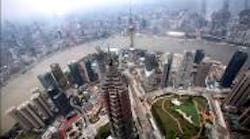"With the phenomenon of mega-cities exploding, particularly in the developing world, some cities now consume more than their states can provide. Lagos eats 45% of Nigeria's energy, and in India, urban centers eat 85%. As these 'feral' cities grow, what you end up having are islands of alternate governance in sovereign seas of state authority. The developing cities are uncontrollable by their so-called owning states.” –Richard Norton, professor of national security affairs at the Naval War College
The growth of “mega-cities” is a topic that’s been touched on in this space before, especially in terms of the transportation ramifications endemic within such potentially huge clusters of humanity.
But when such mammoth enclaves start getting called “feral cities” by many experts ... well, you know a far darker vision of the future is being forecast.
Defined as urban areas with a population of 10 million or more, there are now today some 11 such “mega cities” with populations of 15 million or more and just five years from now, the world is projected to have 24 of them.
Yet as this “mass urbanization” trend kicks into high gear, what are the ramifications for business, consumer goods and commercial markets, security, infrastructure, and the workforce, much less transportation networks?
And by using the term “feral,” are we saying we’re inevitably heading towards a form of existence often detailed on the darker landscapes of science fiction, by such films as Blade Runner?
[And it’s worthy to note in this clip that Los Angeles envisioned as having population of over 106 million by 2019 in this cinematic masterpiece; roughly equal to one-third the total U.S. population today.]
These are just some of the issues debated at a conference held in May by a group with the ungainly title of WomenCorporateDirectors (WCD). The group, comprised of over 1,000 female corporate directors serving on over 1,200 boards around the world, delved into the challenges posed by the creation of massive urban centers.
“As urban centers develop a stronger field of gravity within their countries, maybe we don't need a G20 of nations anymore – maybe we need a G20 of cities,” Annette Schommel, founder of Arthesia and a director for Kuoni Reisen Holding. “I'm not so sure that the U.K. will be a member of the G20 in ten years, but I'm pretty sure that London will still be a mega-city even 50 years from now.”
“One in 25 people in the world lives in Chinese cities,” added Elaine LaRoche, a former director of China Construction Bank. “In 20 years, over 220 Chinese cities will have populations of over a million, with 23 cities over five million and several over 20 million – and the Chinese are even studying the feasibility of cities of over 40 million.”
The rise of such mammoth cities brings with it significant challenges, said the conference panelists – from providing enough energy, transportation, and food, to creating a safe and secure environment in which business can operate.
Take energy: a necessary part of a vital city, said Linda Goodspeed, vp-information systems for Nissan North America.
“Developing countries like India will increase utilization of computers and electronics, which means that energy needs are going to put a tremendous drain on the current generation and distribution systems," she said. "Energy storage is going to become more important than ever before.”
Feeding such mammoth conglomerations of humans is another big worry – one tied directly to transportation. Lars Thunell, executive vp of the World Bank's International Finance Corp., said at the conference this will require massive investments in agribusiness across the food supply chain – from farming to transportation and storage to food processing.
“Roughly 40% of food produced in the developing world spoils before it reaches the consumer,” he explained. “Investing in better logistics and processing to recapture this wasted food is one way to increase food supply without using more resources like water and land.”
Another basic need threatened by such “feral cities” is safety. In many of the big sprawling urban centers today – from Mexico City to Brazil's "favelas" – security challenges are overwhelming the capacity of law enforcement. In one example, South Africa was so concerned about the personal security of its stockbrokers that it had to move its stock exchange out of the downtown central business district of Johannesburg to a suburb 20 miles away.
Ultimately, the panelists at WCD’s conference believe governments and businesses around the world will have to completely shift their thinking about what is most needed by “mega-cities,” and where the opportunities, and weaknesses, really lie.
“Boards today have to ask management to stress test the supply chain," said Nissan’s Goodspeed. “We are going to run out of natural resources in some areas, but there may be alternate resources in other areas to compensate. We have to ‘stress test’ the possibilities: What if a city grows two or three times faster than you think? What happens to your energy supply? What happens to your supply chain?”
And while we might laugh about comical portrays about the “mega cities” of the future, where lawlessness and deprivation are rampant – the notoriously wretched movie Judge Dredd (see below) comes to mind – in reality, they are already here and growing larger every day.
“Urban growth is surging worldwide and currently, over half the world's population lives in cities,” noted Mohamed Mubarak, an automotive and transportation group industry analyst with research firm Frost & Sullivan, in a special analyst briefing last year.
Mubarak said the spatial expansion of cities and the resultant change in mobility patterns will foster new modes of commuting and a broader shift towards eco-friendly transportation. On top of that, there will be more demand for “integrated mobility” and more regulations governing vehicular movement, he explained.
And it’s not all about transportation, either. Urbanization expert Dr. Willfried Wienholt, for one, believes future urban development strategies must give greater consideration to the principle of sustainability as, between now and 2030, 90% of global population growth will occur in cities.
Wienholt’s research indicates that an additional two billion inhabitants will move into urban centers in Asia, Africa, Latin America and the Middle East during this period, putting a huge strain on infrastructure and the environment.
Consider water, for example, Wienholt said. Cities already consume 60% of all drinking water worldwide, either directly or indirectly as water for raising food products. With regard to energy, the state of São Paulo—the largest urban area in South America—accounts for 60% of total energy consumption in Brazil.
“Suitable housing and access to clean drinking water for all, power supplies and transport systems that are as efficient and environmentally friendly as possible, and land use and construction projects that proceed in accordance with the principle of sustainability, will all be required,” said Wienholt.
Transportation in particular will be strongly affected by all of this, Frost & Sullivan’s Mubarak stressed.
“There will be a strong and steady growth in demand for conventional vehicles in the developing economies whereas the cities of the developed economies will undergo a transformation, witnessing the trial of a series of personal mobility concepts ranging from bicycle hire programs to on demand personal mobility services on a larger scale,” he pointed out. “The vehicle ownership trends in these cities will see a higher adoption of bikes, electric vehicles, city-centric cars and other forms of compact motorized vehicles not seen before.”
So whether the “mega cities” of the future go “feral” or develop far more pleasant characteristics instead, one thing is for certain: they are here now and they will only get larger. That means transportation and logistics experts from across the spectrum need to start thinking now about how they will adapt in order to serve the growing number of ever more massive urban centers in the none to distant future.



